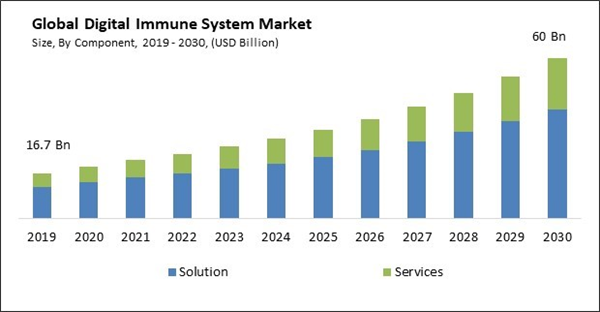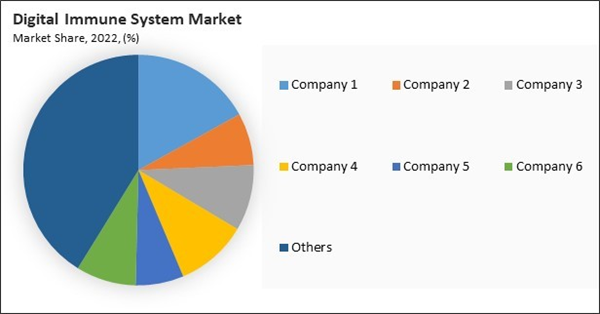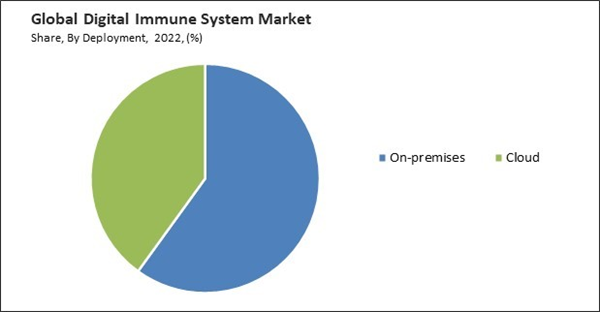The Global Digital Immune System Market size is expected to reach $60 billion by 2030, rising at a market growth of 12.2% CAGR during the forecast period.
Healthcare organizations handle sensitive patient information, making them prime targets for cyberattacks. Digital immune systems are instrumental in protecting electronic health records (EHRs) and ensuring the privacy and confidentiality of patient data. Therefore, the healthcare sector would acquire 1/5th share of the market by 2030. The healthcare sector has experienced a rise in cyber threats, including ransomware attacks, data breaches, and phishing incidents. Digital immune systems provide real-time threat detection and response capabilities to thwart these threats. Owing to these factors, there will be a rise in demand in the healthcare segment. Some of the factors impacting the market are rising number of cyber threats across industries, accelerated digitalization in various organizations, and lower adoption rate in small and medium-sized businesses.
As cyber threats become more pervasive and sophisticated, organizations across industries must bolster their cybersecurity measures. The escalating threat landscape creates a strong demand for advanced security solutions, such as digital immune systems, which can provide proactive, adaptive, and holistic protection against these evolving threats. These systems bolster cyber resilience by offering real-time threat detection and rapid response capabilities. By adopting these systems, organizations can reduce the risk of suffering significant financial losses, reputation damage, and operational disruptions resulting from cyberattacks. This risk mitigation is attractive for businesses seeking to protect their assets and reputation. Additionally, the adoption of new technologies and the shift to digital operations expand the attack surface for potential cyber threats. With more entry points for cybercriminals, the demand for robust security solutions, such as digital immune systems, increases. Digital transformation often results in complex, hybrid IT environments, including on-premises systems, cloud-based services, IoT devices, and remote workforces. Digital immune systems are designed to provide security across these diverse environments, making them an ideal choice for organizations seeking comprehensive protection. As businesses expand and their digital footprint grows, digital immune systems can scale to accommodate these changes while maintaining high security. Therefore, the demand for these systems will increase in the coming years.
However, Small, and medium-sized businesses (SMBs) often have limited budgets for cybersecurity investments. The high initial cost of deploying these systems may place them out of reach for these organizations. As a result, smaller businesses might forego implementing advanced cybersecurity solutions, limiting the market's potential customer base. The cost barrier can create disparities in access to advanced cybersecurity solutions. Smaller organizations often serve as hotbeds for innovation. When they face barriers to adopting advanced cybersecurity solutions, it may hinder innovation and the development of new technologies that could benefit the entire market. Thus, these factors will decrease demand in the market.
The leading players in the market are competing with diverse innovative offerings to remain competitive in the market. The above illustration shows the percentage of revenue shared by some of the leading companies in the market. The leading players of the market are adopting various strategies in order to cater demand coming from the different industries. The key developmental strategies in the market are Acquisitions, and Partnerships & Collaborations.
The market research report covers the analysis of key stake holders of the market. Key companies profiled in the report include IBM Corporation, Cisco Systems, Inc., Microsoft Corporation, Broadcom Inc., HCL Technologies Ltd. (HCL Enterprises), Trend Micro, Inc., McAfee Corp., Palo Alto Networks, Inc., FireEye, Inc., and Fortinet, Inc.
Healthcare organizations handle sensitive patient information, making them prime targets for cyberattacks. Digital immune systems are instrumental in protecting electronic health records (EHRs) and ensuring the privacy and confidentiality of patient data. Therefore, the healthcare sector would acquire 1/5th share of the market by 2030. The healthcare sector has experienced a rise in cyber threats, including ransomware attacks, data breaches, and phishing incidents. Digital immune systems provide real-time threat detection and response capabilities to thwart these threats. Owing to these factors, there will be a rise in demand in the healthcare segment. Some of the factors impacting the market are rising number of cyber threats across industries, accelerated digitalization in various organizations, and lower adoption rate in small and medium-sized businesses.
As cyber threats become more pervasive and sophisticated, organizations across industries must bolster their cybersecurity measures. The escalating threat landscape creates a strong demand for advanced security solutions, such as digital immune systems, which can provide proactive, adaptive, and holistic protection against these evolving threats. These systems bolster cyber resilience by offering real-time threat detection and rapid response capabilities. By adopting these systems, organizations can reduce the risk of suffering significant financial losses, reputation damage, and operational disruptions resulting from cyberattacks. This risk mitigation is attractive for businesses seeking to protect their assets and reputation. Additionally, the adoption of new technologies and the shift to digital operations expand the attack surface for potential cyber threats. With more entry points for cybercriminals, the demand for robust security solutions, such as digital immune systems, increases. Digital transformation often results in complex, hybrid IT environments, including on-premises systems, cloud-based services, IoT devices, and remote workforces. Digital immune systems are designed to provide security across these diverse environments, making them an ideal choice for organizations seeking comprehensive protection. As businesses expand and their digital footprint grows, digital immune systems can scale to accommodate these changes while maintaining high security. Therefore, the demand for these systems will increase in the coming years.
However, Small, and medium-sized businesses (SMBs) often have limited budgets for cybersecurity investments. The high initial cost of deploying these systems may place them out of reach for these organizations. As a result, smaller businesses might forego implementing advanced cybersecurity solutions, limiting the market's potential customer base. The cost barrier can create disparities in access to advanced cybersecurity solutions. Smaller organizations often serve as hotbeds for innovation. When they face barriers to adopting advanced cybersecurity solutions, it may hinder innovation and the development of new technologies that could benefit the entire market. Thus, these factors will decrease demand in the market.
The leading players in the market are competing with diverse innovative offerings to remain competitive in the market. The above illustration shows the percentage of revenue shared by some of the leading companies in the market. The leading players of the market are adopting various strategies in order to cater demand coming from the different industries. The key developmental strategies in the market are Acquisitions, and Partnerships & Collaborations.
Component Outlook
Based on component, the market is bifurcated into solution and services. In 2022, the services segment garnered a significant revenue share in the market. Digital immune system solutions can be complex, requiring specialized knowledge and expertise. Implementation services involve deploying the system within an organization's existing IT infrastructure. These services ensure the digital immune system is correctly configured, integrated with other security tools, and aligned with the organization's needs. As more organizations adopt digital immune systems, the demand for implementation services has surged. Thus, there will be increased demand in the services segment.Deployment Outlook
On the basis of deployment, the market is divided into on-premises and cloud. The on-premises segment recorded the maximum revenue share in the market in 2022. Numerous firms are subject to stringent data sovereignty and compliance standards, especially those in highly regulated sectors like finance and healthcare. On-premises solutions provide greater control over data and ensure that sensitive information remains within the organization's physical boundaries, which can be essential for compliance. On-premises digital immune systems offer a higher level of security and isolation. Organizations can create and manage their secure environment with dedicated resources, reducing the risk of data breaches and unauthorized access. Therefore, there will be a rise in demand in the on-premises segment in the coming years.Security Type Outlook
Based on security type, the market is segmented into network security, cloud security, endpoint security, Internet of Things (IoT) security, and others. The network security segment held the largest revenue share in the market in 2022. The digital landscape is fraught with many cyber threats, including malware, ransomware, phishing, and advanced persistent threats (APTs). These threats often target network vulnerabilities. Organizations turn to digital immune systems equipped to detect and respond to network-based threats to combat these evolving challenges proactively. Network security is fundamental in the realm of digital immune systems. These systems operate at the core of an organization's network, monitoring traffic, identifying anomalies, and neutralizing potential threats.Industry Outlook
On the basis of industry, the market is divided into IT & telecom, BFSI, manufacturing, healthcare, government, and others. The government segment recorded a considerable revenue share in the market in 2022. Governments are prime targets for cyber threats due to the critical nature of their services and the sensitivity of the data they handle. The increasing sophistication of cyberattacks, such as nation-state actors and ransomware campaigns, has heightened the urgency for government agencies to adopt advanced security measures. Government agencies oversee critical infrastructure sectors, including energy, transportation, water supply, and healthcare. A breach in these areas could have far-reaching consequences, making protecting critical infrastructure a top priority.Regional Outlook
By region, the market is segmented into North America, Europe, Asia Pacific, and LAMEA. The North America segment procured the highest revenue share in the market in 2022. North America deeply understands the cybersecurity landscape, driven by frequent cyber threats and data breaches. As a result, organizations in this region prioritize advanced cybersecurity solutions, including digital immune systems. The region faces a highly sophisticated and diverse range of cyber threats. This complexity has necessitated the adoption of advanced threat detection and response capabilities provided by digital immune systems. These factors are expected to increase the demand in the North America segment in the coming years.The market research report covers the analysis of key stake holders of the market. Key companies profiled in the report include IBM Corporation, Cisco Systems, Inc., Microsoft Corporation, Broadcom Inc., HCL Technologies Ltd. (HCL Enterprises), Trend Micro, Inc., McAfee Corp., Palo Alto Networks, Inc., FireEye, Inc., and Fortinet, Inc.
Scope of the Study
Market Segments Covered in the Report:
By Component- Solution
- Services
- On-premises
- Cloud
- IT & Telecom
- Government
- BFSI
- Manufacturing
- Healthcare
- Others
- Network Security
- Cloud Security
- Endpoint Security
- Internet of Things (IoT) Security
- Others
- North America
- US
- Canada
- Mexico
- Rest of North America- Europe
- Germany
- UK
- France
- Russia
- Spain
- Italy
- Rest of Europe- Asia Pacific
- China
- Japan
- India
- South Korea
- Singapore
- Malaysia
- Rest of Asia Pacific- LAMEA
- Brazil
- Argentina
- UAE
- Saudi Arabia
- South Africa
- Nigeria
- Rest of LAMEA
Key Market Players
List of Companies Profiled in the Report:
- IBM Corporation
- Cisco Systems, Inc.
- Microsoft Corporation
- Broadcom Inc.
- HCL Technologies Ltd. (HCL Enterprises)
- Trend Micro, Inc.
- McAfee Corp.
- Palo Alto Networks, Inc.
- FireEye, Inc.
- Fortinet, Inc.
Unique Offerings
- Exhaustive coverage
- The highest number of Market tables and figures
- Subscription-based model available
- Guaranteed best price
- Assured post sales research support with 10% customization free
Table of Contents
Chapter 1. Market Scope & Methodology
Chapter 2. Market at a Glance
Chapter 3. Market Overview
Chapter 4. Competition Analysis - Global
Chapter 5. Global Digital Immune System Market by Component
Chapter 6. Global Digital Immune System Market by Deployment
Chapter 7. Global Digital Immune System Market by Industry
Chapter 8. Global Digital Immune System Market by Security Type
Chapter 9. Global Digital Immune System Market by Region
Chapter 10. Company Profiles
Companies Mentioned
- IBM Corporation
- Cisco Systems, Inc.
- Microsoft Corporation
- Broadcom Inc.
- HCL Technologies Ltd. (HCL Enterprises)
- Trend Micro, Inc.
- McAfee Corp.
- Palo Alto Networks, Inc.
- FireEye, Inc.
- Fortinet, Inc.











